Chapter 10 India – Climate Of India Introduction :
Climate Of India:
India has a great diversity of climates. There are great variations in climates from region to region because India has a variety of temperatures, rainfall, air pressure etc. in its various region.
Nevertheless, there is a similarity in all these varieties, the impact of the monsoon winds in all parts of the country. Hence, it is known as the ‘land of monsoon’. The word ‘monsoon’ is derived from the Arabic word ‘Mausim’ which means ‘season’.
“WBBSE class 6 physical geography chapter 10 notes”
The ‘Tropic of Cancer passes through the middle of the country. It clearly demarcates the country into the ‘tropical region’ to the south of it and the sub-tropical and temperate region to the north of it. Hence, the climate of India is broadly described as a ‘Tropical Monsoon’ type.
The Controlling Factors Of Indian Climate :
There are various factors which influence the climate of India. The factors that indicate a dominant influence on the climate of India are as follows :
1. Latitude
Read and Learn More WBBSE Notes For Class 6 Junior School Geography
Latitudinally, India extends from 8°04′ north latitude in the south to 37°06′ north latitude in the north. So, India belongs to the ‘Torrid Zone’. The ‘Tropic of Cancer’ (23°30′ north latitude) passes through the middle of the country.
So, a hot and humid Tropical climate prevails in South India and a cold and temperate climate prevails in North India.
2. Altitude
The altitude of the land plays an important role in the variation of temperature. It is due to the higher altitude of the northern mountains they are colder than plain regions.
In the Deccan plateau, temperatures remain relatively low in the summer months though it lies in the Torrid Zone. It is because temperature decreases with increasing altitude.
3. Location of Mountain :
The transverse location of the lofty Himalayan Mountains forms a barrier which affects the climate of India such as follows :
- It helps to trap the Monsoon wind forcing them to shed their moisture which gives plenty of rain in summer within the country.
- It prevents the cold winds of North Asia from blowing into India and protects it from the severe cold wind in winter.
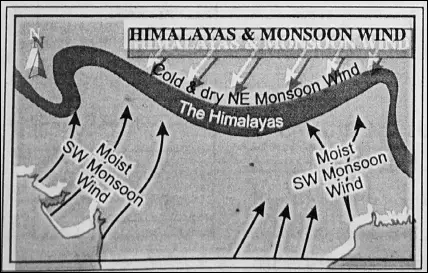
4. Wind
India has a monsoon climate. Monsoons are land breezes and sea breezes on a large scale. As the winds blowing over the Indian sub-continent reverse their directions seasonally, they are known as ‘Monsoon winds’.
The southwest monsoon and the northeast monsoon play the most important role in formulating the climatic characteristics of our country. For their profound influence over the climate of India, the country is called ‘the land of Monsoon’.
| Class 6 History | Class 6 Social Science |
| Class 6 Geography | Class 6 Science |
| Class 6 Maths | Class 6 Science MCQs |
| Class 6 General Science | Class 6 Maths Solutions |
| Class 6 Geography | Class 6 Hindi |
“climate of India WBBSE class 6 geography notes”
In summer, the monsoon winds blow from sea to land as South-West monsoon heavy rainfall occurs. In winter, the monsoon blow from sea to land as South-West monsoon heavy rainfall occurs. In winter, the monsoon winds blow from land to sea as North-East Monsoons and these dry winds occur a little rainfall.
5. Distance from the sea :
Places quiet away from the sea (areas in the interior) have a-higher relative diurnal and annual ranges of temperature. So, they experience an extreme or continental type of climate.
Such as Delhi, Ludhiana etc. of North-west India. But the places situated in coastal areas experience equable maritime climates. Their annual range of temperature is minimum. Mumbai, Chennai, Thiruvananthapuram and other coastal regions experience the influence of the sea, thereby, having a moderate temperature.
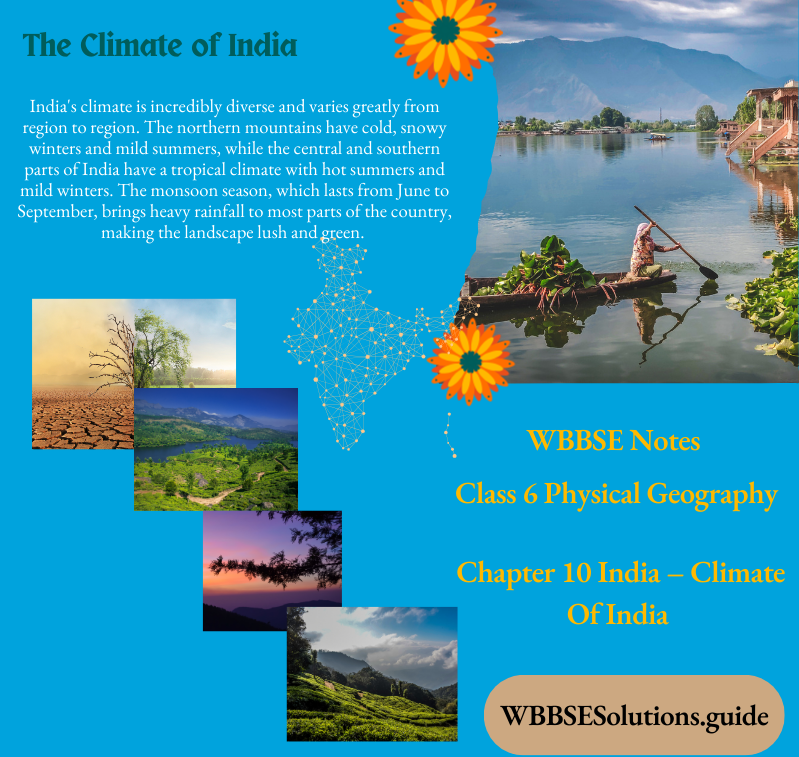
The Climatic Characteristics Of India :
Climate India is a ‘Tropical Monsoon’ type. The characteristics of the Indian climate are as follows :
- The climate of India is mainly influenced by Monsoon winds and the Himalayas.
- The nature of the monsoon climate is hot and humid. In India, the summer is hot and humid.
- Most of the rain is received from South-West Monsoons during the period of mid-June to mid-September. It is seasonal rainfall.
- India is noted for its diversity of rainfall. The rainfall is unevenly distributed over the country.
- Winter is mild and dry. Most of the rainfall (more than 85%) is received in summer.
- Summer rainfall is uncertain due to the ‘gambling of the monsoons’. Sometimes monsoons start early or occurs heavy rainfall in a short time resulting in floods. On the other hand, often the onset of monsoon is delayed resulting in drought. The early or late retreat of monsoons also results in serious droughts.
- The amount of rainfall is determined by the presence of mountains.
- Most of the areas of India have variable rainfall as much as 30 cm plus or mountains.
- While Mowsinram-Cherapunji receives more than 1200 cm of rainfall, the northern part of India is cooler compared to the southern part.
- On a summer afternoon the ‘Thar Desert’ of Rajasthan may be 50°C while on a winter night in the Ladakh plateau, it is – 40°C.
The Climatic Regions Of India :
The climate is the aggregate of atmospheric conditions over a wide area for a long period of time (say at 35 years). The natural division of the Earth according to the distinctive characteristic features of climate is called a ‘Climatic Region’.
“summary of class 6 physical geography chapter 10 WBBSE”
Koppen, Thorthwaite, Kendrew, Stamp, Miller etc. have attempted to classify India into different climatic regions. Of these, Koppen’s classification seems to be the most acceptable and following it Indian climatic regions are presented here.
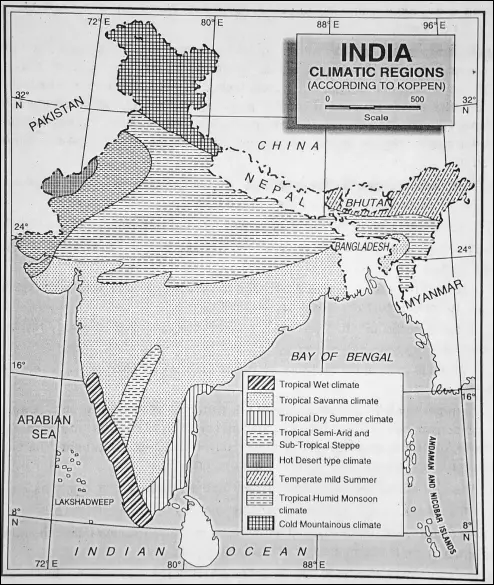
1. Tropical and sub-tropical Humid Monsoon climate :
This kind of climate is found in Ganga and Sutlej plains, the Brahmaputra valley and parts of the Central Plateau and Highland region.
2. Arid Climate :
The Desert or Marusthali region of Rajasthan is included in this climatic region.
3. Semi-Arid Climate :
This kind of climate prevails in the Rohi and Bagar areas of Rajasthan, the southern part of Punjab and Haryana and the rain-shadow area of Maharashtra and Karnataka.
4. Tropical Savanna climatic region :
This kind of climate occurs in Gujarat, Maharashtra, Central and Southern Madhya Pradesh, Chhattisgarh, Andhra Pradesh, Telangana, West Tamil Nadu, Jharkhand and South-western West Bengal.
5. mountain climate or cold Mountainous region :
The High altitudes of the Western Himalayas including Kashmir and Ladakh fall within this climatic region.
6. Tropical West Climate :
This kind of climate prevails in the Konkan and Malabar coasts where the average annual rainfall is 300 cms or more and temperature varies between 18°C and 27°C.
“important questions from climate of India class 6”
Seasons in India :
Monsoon winds dominate the climate of India. India has a broad unity of Tropical Monsoon type of climate. The monsoon type of climate is characterised by distinct seasonality.
Based on the arrival and departure of monsoon winds, rainfall, temperature and air pressure, the Meteorological Depart, of the Government of India has divided the climate of India into four seasons, which rotate in a cycle as follows :
| (1) The hot weather season or summer. | March to May |
| (2) The southwest Monsoon season or the rainy season. | June to September |
| (3) The season of retreating monsoon or Autumn. | October to November |
| (4) The cold weather season or winter. | December to February |
The Hot Weather season or summer
Summer is the season previous to the arrival of the southwest monsoon winds. From March to the end of May or mid-June is the hot season or summer in India.
Temperature
A rapid increase in temperature is witnessed because the sun moves northwards and shines vertically near the ‘Tropic of Cancer’. The average temperature is above 30°C.
May is the hottest month of this season in India. In the month of May, the temperature rises to 40°C. In Kolkata, the average daytime temperature maximum reaches to 35°C in the month of May.
Pressure and wind
The summer is a period of rising temperature and decreasing air pressure conditions of low pressure develops over north-west and central India. Local violent storms occur during April-May.
They approach from the northwest accompanied by thunder and torrential rain, hence they are known as ‘Nor-westers’. They are locally, especially in West Bengal are called ‘Kalbaishakhi’ (i.e. the disaster of the month of Baisakh).
“WBBSE class 6 geography chapter 10 key points”
In the coastal region of South India, especially in the western coastal region of Kerala and Karnataka, the local storms are known as ‘Mango Showers’. In summer, a hot dry wind blows in the north-western parts of India.
It is known as ‘Loo’. It is very common in Punjab, Haryana, Uttar Pradesh and Bihar. Sometimes a hot dry wind accompanied by dust storms in North-West India, especially in the desert area of Rajasthan occur in the afternoon are locally known as ‘Andhi’.
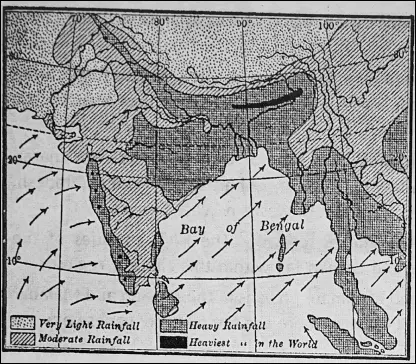
Rainfall :
Most of the country is dry in the pre-monsoon period. But there are some areas, especially on the coastal areas of south India receive convectional rainfall. The west coast also starts receiving rainfall with ‘mango showers’.
Thunder shower known as ‘Kalbaishakhi’ in West Bengal and ‘Bardai Chhila’ in Assam are also bring some rainfall which decrease temperature locally.
Rainy Season (June to September)
The rainy season lasts from June to September. The southwest monsoon generally blows from June to September. They bring rain. For this reason, the season is known as the southwest monsoon or Rainy Season.
Temperature :
On the 21st June, the sun shines vertically over the ‘Tropic of Cancer’. Therefore, temperatures are high (more than 30°C). With the onset of monsoon, there is a drop in temperature (5°C to 30°C). With a result, June or July is not the hottest month.
Pressure and Wind :
During this time, though the landmass gets heated to a very great extent, an area of very low pressure develops over the Indian subcontinent.
This low-pressure zone attracts the southeast trade wind which on crossing the equator becomes southwest monsoon winds (according to Ferrel’s law) and arrives the western coasts of India all of a sudden with furious speed and violent thunder and lightning. The advent of these violent winds is known as the ‘Burst of Monsoon’.
On reaching the Indian sub-continent they are divided into two branches-
(1) The Arabian sea branch and
(2) Bay of Bengal branch.
Rainfall:
South-west monsoons are rain givers as most of the subcontinent gets rainfall in this season. The Arabian sea branch gives heavy rainfall on the west coast, but Deccan Plateau lies in the rain-shadow are of the Western Ghats.
The Bay of Bengal branch gives heavy rainfall to the southern slopes of the Himalayas and the Meghalaya Plateau (Garo, Khasi hill etc.) Mowsinrarrtgaon near Cherapunji receives the highest rainfall (about 1250 cm) in the world.
But Shillong lies in the rain-shadow area of the Meghalaya plateau (Khasi hill). Monsoon winds after descending down the slopes give less rainfall at Shillong. Except for the desert of the North-West, the rest of India receives rainfall varying between 60 – 200 cm. 80% of rainfall occurs in the rainy season. Rainfall is mostly (80%) orographic in nature.
The Season of Retreating Monsoon or Autumn (October-November) :
This is the period of transition between the final withdrawal of the southwest monsoon and the regular setting of the northeast monsoons.
Temperature :
The sun beings to move towards the equator. There is a decrease in temperature in north India. Hot and sticky Weather is found in other parts of India.
Pressure and Wind:
South-west monsoons begin to withdraw from the subcontiniÿ’Siurfhgÿtiÿe’1ÿ’ week of October. Some tropical cyclones are developed particularly on the coastal strip of the Bay of Bengal. In West Bengal, these cyclones are locally known as ‘Aswiner Jhar’.
Rainfall :
Heavy rainfall occurs in coastal areas. Cool weather begins in NorthWest India, But the southern parts of India have an equable climate.
The Cold Weather Season (Winter)
The cold season or winter lasts from December to February.
Temperature:
On the 22nd of December, the sun is overhead at the ‘Tropic of Capricorn’ arid the temperature in north India becomes very low. January is the coldest month. The temperature decreases from south to north.
It varies from 10°C to 25°C. The average temperature of winter in North India varies from 10°C to 15°C while in South India it rises to 25°C. So, the southern parts of India have warm conditions while low temperatures (winter) are found in North and North West India.
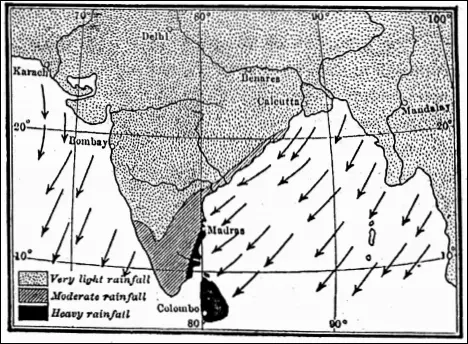
Pressure and winds :
High pressure is developed over the North-West of India while a low pressure exists over the Indian Ocean with a result of winds blowing from land to sea (Ocean). The outflowing winds are Westerly in Northern plain and North-Easterly over the rest of the country.
Rainfall :
The North-East Monsoon wind is very dry. So, it does not give sufficient rainfall in India but causes snowfall on the higher altitudes of the Himalayas. The North-East monsoon winds pick up some moisture while crossing the Bay of Bengal and give rain to the South-East coast of India, especially in the Coromandel Coast of Tamil Nadu.
“major climatic regions of India class 6 notes”
During winter, the stable conditions of weather in North-West India are disrupted by a series of shallow cyclonic disturbances from the Mediterranean Sea.
These are known as ‘Western Disturbances’, which also bring a small amount of rainfall (10 to 20 cms) in North and North-West India. Such winter rainfall is beneficial to wheat cultivation, especially in North-West India.
The Influence of Monsoon on Indian Climate:
South-West Monsoon wind gives rain in India, but this wind is irregular and uncertain. Some years it arrives early, some years late. Sometimes rainfall occurs continuously for a few days. Sometimes, it is rainless for a long time.
Excessive rain causes floods and lack of-rain causes droughts. As a result droughts and floods are common in India. Monsoon wind is seasonal. So, Indian rainfall is seasonal.
“factors affecting the climate of India WBBSE”
Due to the uneven distribution of rainfall Indian climate is not similar all over India during the same time. The. states of Assam, West Bengal and Bihar experience floods while drought occurs in Gujarat and Rajasthan.
The Influence of Monsoon on India’s Agriculture:
Indian agriculture and economy is mostly dependent on monsoon rainfall as well as South-West-Summer monsoon winds. The summer crops on Kharif crops are dependent on monsoons. Good rains have resulted in bumper crops productions.
“monsoon winds and their impact on India’s climate”
The uniform distribution of rain results in multiple cropping. Heavy rainfall leads to devastating floods that cause crop failure. Scanty rainfall may cause extensive drought conditions when no crops can be produced.
WBBSE Notes for Class 6 Junior School Geography
- Chapter 1 The Universe and Solar System
- Chapter 2 Shape of The Earth: Is The Earth Around?
- Chapter 3 Location of a Place on The Earth’ Surface: Where You Are
- Chapter 4 The Earth’s Motion: The Earth Rotation
- Chapter 5 Water – Land – Air
- Chapter 6 The Ice Capped Continent: Antartica
- Chapter 7 Weather And Climate
- Chapter 8 Air Pollution
- Chapter 9 Noise Pollution
- Chapter 10 India
